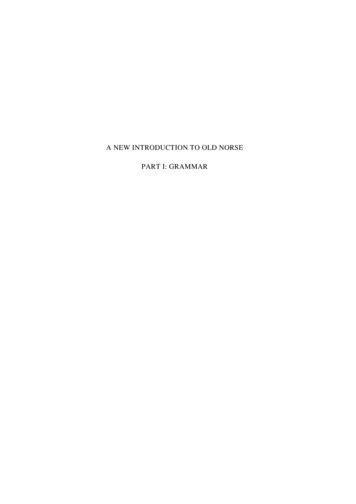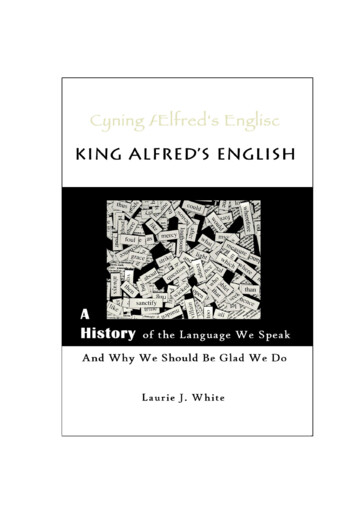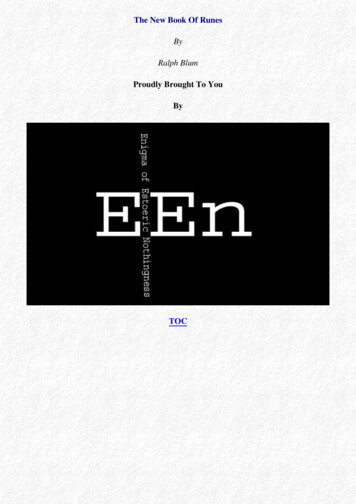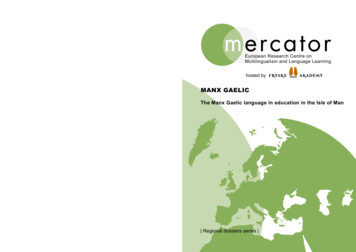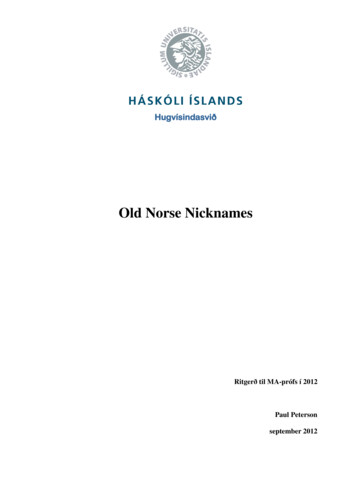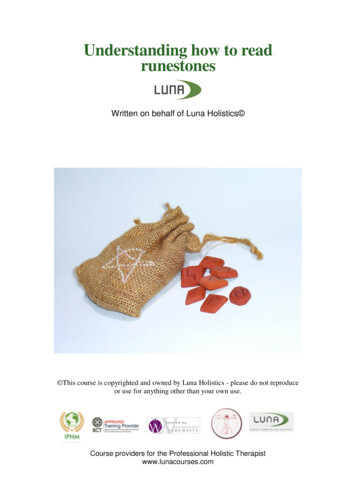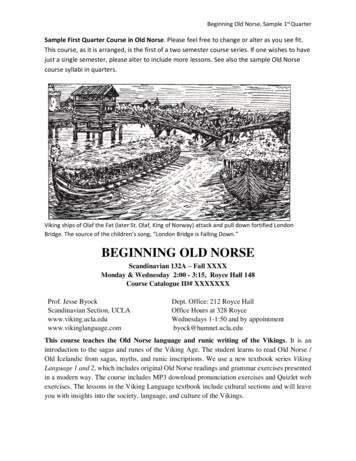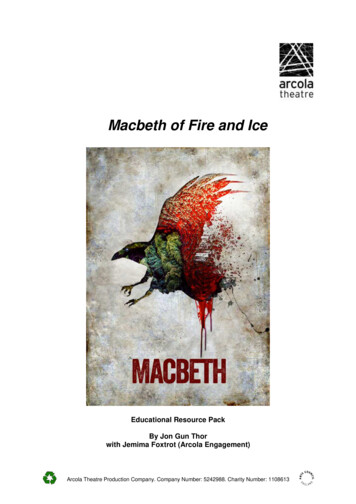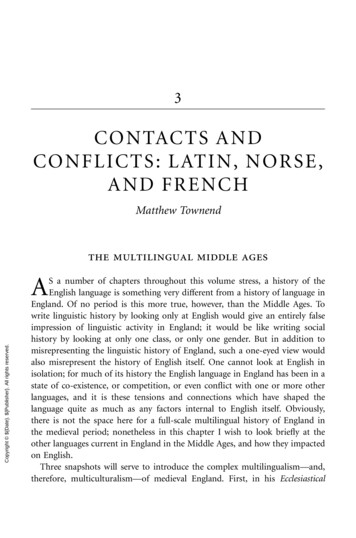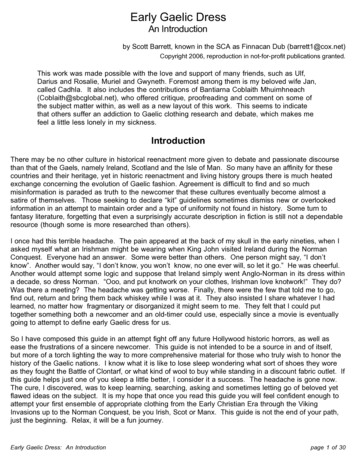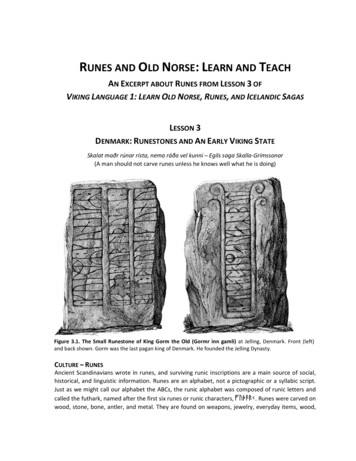
Transcription
RUNES AND OLD NORSE: LEARN AND TEACHAN EXCERPT ABOUT RUNES FROM LESSON 3 OFVIKING LANGUAGE 1: LEARN OLD NORSE, RUNES, AND ICELANDIC SAGASLESSON 3DENMARK: RUNESTONES AND AN EARLY VIKING STATESkalat maðr rúnar rísta, nema ráða vel kunni ̶ Egils saga Skalla-Grímssonar(A man should not carve runes unless he knows well what he is doing)Figure 3.1. The Small Runestone of King Gorm the Old (Gormr inn gamli) at Jelling, Denmark. Front (left)and back shown. Gorm was the last pagan king of Denmark. He founded the Jelling Dynasty.CULTURE – RUNESAncient Scandinavians wrote in runes, and surviving runic inscriptions are a main source of social,historical, and linguistic information. Runes are an alphabet, not a pictographic or a syllabic script.Just as we might call our alphabet the ABCs, the runic alphabet was composed of runic letters andcalled the futhark, named after the first six runes or runic characters, FUÞARK. Runes were carved onwood, stone, bone, antler, and metal. They are found on weapons, jewelry, everyday items, wood,
JESSE BYOCK, VIKING LANGUAGE 1: LEARN OLD NORSE, RUNES, AND ICELANDIC SAGAS2and bark. Runes were used for identification, commemoration, messages, and magic. Runicinscriptions are the closest written sources to the speech of the Viking Age.The earliest runes date to the first century CE, and runes were then used in Scandinavia for thenext 1300 years or more. Almost surely, runes wereadapted from writing systems employed in theRoman Empire. At that time, there wasconsiderable contact between the Roman worldand Germanic peoples. Speakers of Proto-Norseand other Germanic languages probably adaptedthe letters of either Latin or Northern Italicalphabets to fit the sounds of their own languages.They modified the letters in order to make themmore suitable for carving.Those who designed the runes used straightstrokes, a feature which worked well with woodgrain and on stones. Messages were usually shortdue to the limitations imposed by pieces of wood,strips of bark, bones, or tablets of wax. The use ofpen and ink and the art of preparing pages of vellumfor manuscripts were unknown in Scandinaviabefore the conversion to Christianity.Runes were common in Viking times, and the Norse often left traces of their runic writing wherethey traveled. Spelling was not standardized and letters were often left out of words. For example, m- is missing from the word kubl ( kumbl) and -n- from kunukR ( konungr) in King Gorm’s stonepictured above and translated in the reading selection below. Rune carvers sounded out words, andmissing letters sometimes reflect lightly pronounced sounds that were easily dropped. Words wereabbreviated and word divisions often missing. Modern runologists sometimes differ on how totranslate an inscription.Runes were carved by members of all social classes, but property owners most frequently paidfor and raised runestones. Many runestones honor the dead, and they often indicate the wealth andauthority of those who erected the monuments. Inscriptions proclaim family relationships, authority,inheritance and property claims. Runestones, such as those at Jelling, announce the claims ofaristocrats and royalty. Runes were sometimes written in poetic meter (see the runic verses andrunestones in Viking Language 2: The Old Norse Reader). Note that the following runic passageemploys two -r runes: r and z. These two characters were sometimes used in the same inscription(see the discussion of the two -r runes in Section 3.5, Runic Sounds).READING – THE SMALL RUNESTONE AT JELLING, rkaz:but(front): kurmR : kunukR :: karþi : kubl : þusi :: aft : þurui : kunu(back): sina : tanmarkaR : but
JESSE BYOCK, VIKING LANGUAGE 1: LEARN OLD NORSE, RUNES, AND ICELANDIC SAGASSTANDARDIZED OLD NORSE3TRANSLATIONGormr konungr gerði kumbl þessi eptÞurvi (Þyri) konu sína, Danmarkar bót.King Gorm made these monuments in memory ofThyri, his wife, Denmark’s adornment.VOCABULARYaft (aft) see eptirbót acc bót, pl bœtr f adornment; improvement;compensation; remedyDanmǫrk gen Danmarkar f Denmark eptir (also ept/aft) prep [w acc] after (in time); inmemory of; [w dat] after, along gera (also gøra) -ði, -ðr gerr vb make; do, actgerði 3sg past of geraGormr -s m Gorm (personal name); first king ofthe Jelling dynasty in Denmark kona acc konu, gen pl kvenna f wife; woman konungr -s, -ar m kingkumbl pl kumbl n burial monument, mound orcairn (the word on Danish and Swedish runestones is frequently in the plural) sinn f acc sg sína refl poss pron one’s own þessi n acc pl þessi dem pron this, theseÞurvi f Thurvi (þurui personal name, ON Þyri)Þyri acc Þyri f Thyri (þurui personal name)RUNES: THE ELDER AND THE YOUNGER RUNIC ALPHABETSThe futhark had several regional variations, and after its appearance in the first century CE, itcontinued to change over time. Different Germanic peoples, including Goths, Anglo-Saxons, Frisians,and early Scandinavians, used somewhat different runic alphabets. Into the eighth century, the basicrunic alphabet consisted of 24 letters. This early futhark is known as the Elder Futhark, 4 which dividesinto three groups or families called ættir.THE ELDER FUTHARK (24 LETTERS)F u Þ A R K G Wf u þ a r k g wH n i J Y P Z Sh n i je p R st B EM l Q ODtb e m l ng o dRoughly 260 of the approximately 350 known Elder Futhark inscriptions are found in Scandinavia.The remainder are from continental Europe, with some from as far east as the Black Sea. Survivinginscriptions in the Elder Futhark are usually short and appear on artifacts such as jewelry, tools, andweapons. Typically they are found in graves and bogs and on materials that have the best chanceof preservation, such as bone and metal. Presumably, there were longer inscriptions on wood,leather, and other organic materials, but most have been lost. The 65 or so early inscriptions foundon runestones appear mostly in the late Elder Futhark or Proto-Norse period and principally inScandinavia. The Elder Futhark is given here in order to provide background for betterunderstanding the Younger Futhark of the Viking Age. From here on the lessons and exercises teachthe Younger Futhark.THE YOUNGER FUTHARK OF THE VIKING AGE (16 BASIC LETTERS)F u/V þ a/A/@ r kfuþą/o/ǫrkh n i a s/ tht/d b/pniasbm/q l zmlRAround the start of the Viking Age in late 700s, the futhark was shortened to 16 runes. This shortenedalphabet is known as the Younger Futhark. The Gørlev Runestone from Sjælland (the island of Zealandin Denmark) dates from ca. 900; it preserves an early complete Younger Futhark.A full Elder Futhark is carved on the Gotlandic Kylver Runestone from ca. 400 and the Vadstena Bracteate fromca. 600.4
JESSE BYOCK, VIKING LANGUAGE 1: LEARN OLD NORSE, RUNES, AND ICELANDIC SAGAS4The runic letters of the Younger Futhark are simpler than those of the Elder Futhark. Each letterin the Younger Futhark has only one vertical mark or ‘stave’ and can be carved easily and quickly. Therunes of the Younger Futhark are called ‘long-branch runes,’ because they are carved with full or longvertical strokes. With local variations and differences among carvers, the Younger Futhark’s 16 longbranch runes were the common form of Old Norse writing throughout the Viking Age. Like the ElderFuthark, the Younger Futhark divides into ættir, but the ‘families’ are shorter.Inscriptions in the Younger Futhark have been found in many overseas regions of Norse activity,some at a great distance from Scandinavia. For example, an inscription from the fourteenth century wasfound in the north of Greenland. A runic inscription found in Iceland from around the year 900 wascarved on a stone spindle whorl and names a woman called Vilbjǫrg as the owner. Detailed descriptionsof runic writings are also mentioned repeatedly in the sagas. Many inscriptions in the Younger Futharkhave been found in the British Isles, and runic inscriptions have also been found as far away as Greeceand Russia. Especially in the tenth and eleventh centuries, the Byzantine Empire and the Caliphate ofBaghdad were frequent destinations for Norse traders and warriors.SHORT-TWIG RUNES, A VARIANT OF THE YOUNGER FUTHARK! u þfuO/qr cþ ą/o/ǫ rke N i aST bh n istaM l xb m lRShort-twig runes are usually found in Sweden and Norway. They grew in popularity toward the endof the Viking Age and in the following medieval centuries. Short-twig runes were easier to carve thanlong-branch runes, and they were often used as a kind of cursive script among traders. Someinscriptions mix the two systems, such as those found on the Isle of Man in the Irish Sea, where VikingAge settlers came from different regions of Scandinavia.LATER RUNIC VARIATIONSAdditional variants of the Younger Futhark appear toward the end of the Viking Age. For example,eleventh-century dotted runes added sounds such as /e/, /g/, and /y/.H g ye g yIn the mid-eleventh century an expanded medieval futhark came into use in Norway and a few otherareas. Sometimes called ‘futhork,’ it incorporated short-twig runes. This alphabet, like other revised,later runic alphabets, continued in active use for several centuries after the Viking Age.Following the conversion to Christianity, runic writing was increasingly influenced by medievalLatin. In some instances, runes were used to carve Latin inscriptions. One such inscription, dating tothe end of the twelfth century, is found on a leather shoe from Bergen. It has a phrase known fromVirgil (Amor vincit omnia, ‘Love conquers all’) written partially in short-twig runes qmnia: uinsSþ:amqr(omnia:uinciþ:amor, note the short twig S for the letter ‘i’ in uinciþ, ‘conquers’). Uinciþ in long branchrunes is uinsiþ. Runes, often with variations and innovations, remained in usage in Scandinavia untilearly modern times, especially in rural regions.RUNIC SPELLING AND STANDARDIZED OLD NORSESpelling often varies among runic inscriptions because of differences in pronunciation, regionaldialects, personal ability in distinguishing sounds, and the lack of a recognized spelling standard. Forexample, gerði, the past tense of gera, is spelled karþi (karþi/gærði) on the Jelling stone in this lesson
JESSE BYOCK, VIKING LANGUAGE 1: LEARN OLD NORSE, RUNES, AND ICELANDIC SAGAS5but takes the form kIarþi (kiarþi/gjærði) in the Swedish Ramsund inscription (Lesson 5).Similar spelling variations widely exist in Old Norse manuscripts. For example, the infinitive formof the verb gera ‘do, make’ is spelled gøra, gǫra, gǫrva, gǫrwa, giǫrva, giora, and gjǫra in differentmanuscripts. To overcome the problem of variation, scholars adopted a standardized Old Norsespelling for saga editions, dictionaries, and transcriptions of runic writing. Standardized ON is basedprincipally on Old Icelandic, the most conservative of the Old Norse dialects and the one that we knowmost about because of the large number of written sources.SOUNDS OF THE 16 LETTERS OF THE YOUNGER FUTHARKConsonants (Voiced and Voiceless). Because the Younger Futhark has only 16 letters, single runesoften represent more than one sound. For example, the runic symbol b represents the consonantsounds /b/ and /p/, and t represents /d/ and /t/. The difference in these similar sounds is thedistinction of /b/ and /d/ being voiced while /p/ and /t/ are voiceless.Like English consonants, Old Norse consonants are voiced or voiceless. The distinction is whetherthe vocal cords vibrate while the air passes through (producing voiced consonants), or do not vibrate(producing voiceless ones). The results are varying sounds altered one from the other by an obstructionof the free flow of air. For instance, compare the voiceless /s/ in English ‘singer’ to the voiced /z/ in‘zinger.’ A similar distinction is found in the voiced ð and voiceless þ pronunciation of the single Þrune, serving for both sounds. Demonstrate this distinction for yourself. Put your fingertips on yourthroat when you make the above sounds: you will feel the buzz of voicing in the voiced consonantsand not in the voiceless ones. 5 Try also to feel the difference when pronouncing v and f: v is voicedwhereas f is voiceless. One can guess that Viking Age individuals who devised and used the YoungerFuthark and its variants understood this distinction.The buzz in the throat comes from the vocal folds inside the larynx, known as the voice box. The larynx sits inthe neck above the windpipe (the trachea) and in front of the food pipe (esophagus).5
JESSE BYOCK, VIKING LANGUAGE 1: LEARN OLD NORSE, RUNES, AND ICELANDIC SAGAS6Multiple Vowels. Single runes also represent several distinct vowel sounds with some overlap. ForRUNESbTkfÞiUaALATIN EQUIVALENTSCONSONANTSvoiced b / a/æą/a/o/ö/ǫFigure 3.2. Runes of the Younger Futhark and Their Latin Equivalents. Voiced consonants are to the left andvoiceless to the right.instance, the rune u represented the vowel and semi-vowel sounds /u/, /v/, /o/, /y/, /ø/, and /w/. Thetwo a-runes show considerable overlap with A and a representing the sounds /a/, /æ/, /o/, and /ǫ/.RUNIC SOUNDS OF THE VIKING AGE, DISCUSSIONSounds. As symbols, characters, and letters in an alphabet, individual runes reflect sounds. Thefollowing discussion of these sounds relies on the International Phonetic Alphabet, which providesa uniform system of letters and symbols for writing speech sounds.Two r-runes, r and z. A noticeable feature of the futhark is the presence of two r-runes. In theElder Futhark, r represents the sound /r/, while z represents the sound /z/. In West Scandinavia(Norway and Iceland), these two sounds merged by the early Viking Age into the trilled r. In EastScandinavia (Denmark and Sweden), the two sounds generally merged following the dentalconsonants /t/ and /d/, but otherwise remained distinct until the end of the Viking Age. Themodern convention is to transliterate the r rune as lower case r and the z rune as upper case R. 6Vowel sounds for /a/: a and o. Two runes for variants of the vowel sound /a/ are a and o. The arune represents /a/ as in modern English ‘father,’ while o is nasalized sounding much like /æ/ inEnglish ‘tank.’Some vowel and consonant sounds. The Younger Futhark did not distinguish between a number ofvowel and consonant sounds in use during the Viking Age. For example, the runes I, a, and u areletters for the vowel sounds /i/, /a/, and /u/, but there are no specific runes for the commonsounds /e/, /o/, and /ǫ/ (although the rune o, originally used for /a/, came also to be used for /o/).See Elmer H. Antonsen, Runes and Germanic Linguistics, in Trends in Linguistics, Studies and Monographs 140,New York: Mouton de Gruyter 2002, pp. 87 and 304-307. As regards these two runes, Antonsen writes: ‘thesetwo phonemes were consistently and correctly distinguished by writers in runes in Denmark until after thebeginning of the 12th century.’6
JESSE BYOCK, VIKING LANGUAGE 1: LEARN OLD NORSE, RUNES, AND ICELANDIC SAGAS7Similarly there are letters for the consonant sounds /b/, /t/, and /k/, but not for /p/, /d/, and /g/.It is not certain whether rune carvers saw the lack of separate letters as much of a problem. Asexplained below, they often employed one letter for several similar sounds, a solution whichsimplified spelling but not reading.Runes n and q. The runes n and q (representing the sounds /n/ and /m/) were often dropped beforecertain consonants. Hence on the Jelling Runestone, the word konungr is spelled kunukz(kunukR), dropping the second /n/.The long-branch m-rune is carved in two variants: m and q.EXERCISE – RUNIC SCRIPT. Following the example below, transliterate the runes and changethem into standardized Old Norse.RUNIC SCRIPTTRANSLITERATIONtanmarkarEX: tanqarkaz1.2.3.4.5.STANDARDIZED OLD NORSEDanmarkarkurqzþuruisinabutaftReverse the process above and write the following words in runes.STANDARDIZED OLD NORSETRANSLITERATIONYOUNGER FUTHARK: LONG-BRANCH RUNESkunukR6. konungrkonukunu7.kubl8. kumblþusi9. þessibut10. bótREADING – GORM AND THYRI (ÓLÁFS SAGA TRYGGVASONAR IN MESTA)King Gorm and his wife Thyri are also known from Icelandic writings. The Greatest Saga of King OlafTryggvason contains the following passage. Both the thirteenth-century Icelandic saga and the tenthcentury Danish runestone agree in their reference to Queen Thyri as Danmarkarbót (‘Denmark’sAdornment’).Óláfs saga Tryggvasonar in mesta (63.kap)Gormr, sonr Hǫrða-Knúts, var mikill maðrok sterkr. Hann var atgervimaðr. En ekki varhann kallaðr vitr maðr.Gormr fekk konu, er Þyri hét. Hon vardóttir Haralds jarls af Jótlandi. Hann varkallaðr Klakk-Haraldr. Þyri var fríð kona.Hon var mestr skǫrungr af konum áNorðrlǫndum. Hon hét Þyri Danmarkarbót.The Greatest Saga of King Olaf Tryggvason (Ch. 63)Gorm, son of Horda-Knut, was a big and strong man.He was an accomplished man. But he was notcalled a wise man.Gorm married a woman called Thyri. She was thedaughter of Earl Harald of Jutland, who was calledKlakk-Harald. Thyri was a beautiful woman. She wasthe most notable of women in the northern lands.She was called Thyri, Denmark’s Adornment.Note. Old Norse has two words for ‘not’: ekki and eigi, while Modern Icelandic only employs ekki.VOCABULARY
JESSE BYOCK, VIKING LANGUAGE 1: LEARN OLD NORSE, RUNES, AND ICELANDIC SAGAS af prep [w dat] of, by; off (of), out of, fromatgervimaðr m man of accomplishments á prep [w dat] on; upon; at; in dóttir acc, dat, & gen dóttur, pl dœtr, datdœtrum, gen dœtra f daughter ekki adv not en conj but; (less frequently) and er rel particle who; which; that fá fær, fekk, fengu, fenginn vb get, take,procure; grasp; marry; fekk konu got married, litgot a wifefekk 1/3sg past of fá fríðr f fríð, n frítt adj beautiful, handsome, fine hann acc hann, dat honum, gen hans pron he heita heitir, hét, hétu, heitinn vb be calledhét 1/3sg past of heita hon acc hana, dat henni, gen hennar pron sheHǫrða-Knútr -s m Horda-Knut (personal name) jarl -s, -ar m earlJótlandi (dat) n Jutland kalla -að- vb callkallaðr ppart [past participle] of kalla calledKlakk-Haraldr -s m Klakk-Harald (personal name) kona gen pl kvenna f wife; woman maðr acc mann, dat manni, gen manns, nom &acc pl menn, dat mǫnnum, gen manna m man;person, human beingmestr superl adj greatest mikill f mikil, n mikit, comp meiri, superl mestr adj big, tall, great; muchNorðrlǫnd dat Norðrlǫndum n pl Northerncountries or region, Scandinavia ok conj andskǫrungr -s, -ar m notable man or woman, leader sonr dat syni, gen sonar, pl synir, acc sonu m son sterkr adj strongvar 1/3sg past of vera vera er; var, váru; verit vb be vitr acc vitran adj wise8
CULTURE – GORM THE OLD AND THE DANISH JELLING DYNASTYPrehistory. Our knowledge of Danish history begins in the fifth or sixth century with the legendarySkjoldung Dynasty. This famous family had its royal seat at Hleiðr, modern-day Lejre, on the centralDanish island of Zealand (Sjælland, ON Sjáland). The Skjoldungs figure prominently in the IcelandicHrólfs saga kraka (The Saga of King Hrolf Kraki) and Old English Beowulf. Both epics are set in Denmarkduring the sixth-century Migration Period, and, although written and preserved in places outside ofDenmark and far distant from each other, many of the same people appear in both tales.Figure 3.3. Viking Age Denmark (Danmǫrk) is marked by horizontal lines. It included parts of what is todaysouthern Sweden. Although the smallest of the Scandinavian countries, Denmark had the highest percentageof arable land and was the wealthiest and most densely populated of the Viking states. Exposed to attacks fromthe Frankish Empire to the south, Vikings to the north, and Slavic pirates on the Baltic Sea (ON Eystrasalt),Denmark developed early into a cohesive monarchy capable of resisting foreign threats.Although there are relatively few reliable historical sources for Danish history until the mid-10thcentury, Frankish writings tell of Danish kings from the early 9th century such as Godfred, who opposedCharlemagne and the Frankish Empire. In the 930s-940s, a new family of overlords emerges in Denmarkin central Jutland (Jótland) with a power base at Jelling (Jalangrsheiðr). Members of the Jelling dynastyimmortalized themselves through ambitious building programs and monuments. Among thesemonuments are the two runestones whose runes we read in this and the next lesson.Gorm the Old (Gormr inn gamli) was the founder of the Jelling dynasty and the last pagan kingof Denmark. King Gorm’s Runestone is the earliest native documentary source to use the term‘Denmark.’ During Gorm’s lifetime, Hedeby (ON Heiðabýr, Heiðarbýr, or Heiðarbær; ‘town’ or‘dwelling [bær] on the heath [heiðr]’) became a major trading center for goods moving between theBaltic region and Western Europe (see the accompanying map of Viking Age Denmark). Large numbers
10of goods were made in Hedeby’s workshops, and merchants arrived in Hedeby with all manner oftrade goods, exotic wares, and silver. Some of the trade goods came up the great rivers of Russia fromplaces as far away as the territory of the Volga Bulgars, the Khaganate of the Khazars, regions ofCentral Asia, the Greek Byzantine Empire, and the Caliphate of Baghdad.Once in Hedeby, trade goods from theBaltic and further east were transportedwest, across the base of the JutlandPeninsula. The goods were first carted on ashort land road protected by the Danevirke(ON Danavirki), the fortified ‘wall of theDanes.’ Then the goods were loaded ontobarges and transported on a small riverleading to the North Sea coast for shipmentto Frisia, Britain, and Western Europe.Another major land route from Hedeby wentnorth and with a branch leading west to theViking Age port at Ribe (ON Ripar) on thewest Jutland coast facing the North Sea.These land routes connected the BalticHedeby with ports on the North Sea, helpingFigure 3.4. The Main Runic Letters of the Viking Ageto avoid sailing along the northern coast ofFuthark (Lisa LaBracio).Jutland through Eyrarsund and Jótlandshaf(modern straits of Öresund and Kattegat) – waters where Vikings lay in wait. The long, east-westLimfjord (Límafjǫrðr) cutting across the north of Jutland was another east-west sailing route thatoffered some protection from piracy.About the year 930, Gorm’s kingdom probably included all of northern and central Jutland. Thesouthern part of Jutland, including Hedeby, seems to have come under his power a few years later,giving him control of the valuable trade route protected by the Danevirke. Gorm’s authority east ofJutland is more difficult to determine. It probably extended at times to the islands of Funen (DanishFyn, ON Fjón) and Zealand (Danish Sjælland, ON Sjáland), areas which outsiders, such as the Franksand peoples of England, considered Danish. At times Gorm’s power may have extended acrossEyrarsund strait to Skåne (ON Skáney), Halland, and Blekinge (ON Bleiking), in modern Sweden.A Sample Runestone from Lesson 9The Fläckebo (Hassmyra) Runestone commemorates a Swedish húsfreyja (lady of the house). Thecarver of this stone uses a variant @ for the /o/ rune o, as well as two variants for the /s/ rune, s and ;þi a;sikmuntaz;uaz;@þintis; e tr;kuþTRANSLITERATIONbuonti kuþr hulmkoetr lit resa ufter oþintisu kunu seno kumbr hifrya til hasuimura iki betr þon byi
11raþr roþbalir risti runi þisa sikmuntar uar oþintis sestr kuþSTANDARDIZED OLD NORSEBúandi góðr Hólmgautr lét reisa eptir Óðindísu konu sína. Kømr hýsfreyja til Hasvimýra ekki betr, súer býi ræðr. Rauð-Balli(r) risti rúnar þessar. Sigmundar var Óðindísa systir góð.Translate:Figure 9.5. Fläckebo Runestone, Västmanland, Sweden.Known as the Fäckebo ‘a’ Stone.VOCABULARYbúandi & bóandi (also bóndi) genbóanda, m farmer; head of ahousehold, husbandbý (var of bú) dat pl býum n home,house, household; farm; estategóðr f góð, n gott adj goodHólmgautr -s m Holmgaut (personalname)Hasvimýrar m pl Hasvimyrar (placename, see mýrr below)hýsfreyja (var of húsfreyja) f housewifekona gen pl kvenna f woman, wifekømr (var of kemr) 2/3sg pres of komaláta lætr, lét, létu, látinn vb to allow,permit; have something donemýrr acc & dat mýri, gen mýrar, plmýrar f moor, bog, swampÓðindísa f Odindisa (personal name),dísa f ‘goddess’Rauð-Balli m Red-Balli (personal name)ráða ræðr, réð, réðu, ráðinn vb toadvise, counsel; rule, governreisa -ti, -tr vb to raise; láta reisa[stein] have a stone raisedrista -ti, -tr vb to carve, cut, engraveSigmundr -ar m Sigmund (personalname)
12Viking Runes and Old NorseLearn & TeachTHE VIKING LANGUAGE SERIESOld Norse language, runes, Icelandic sagas, Viking history, and literatureJules William PressViking Language 1, Learn Old Norse, Runes andIcelandic Sagas, 2nd Edition (Book 1 in The VikingLanguage Series) by Jesse Byock is a new introductionto Old Norse, Icelandic sagas, and runes. The beginnerhas everything in one book: graded lessons, vocabulary,grammar exercises, pronunciation, extensive maps, andsections on Viking history, literature, and myth.Innovative word-frequency method greatly speedslearning. Modern Icelandic has changed little from OldNorse; students are well on the way to masteringModern Icelandic. ISBN-978-0-9881764-1-6 Availableon Amazon.com and Ingram. Free Answer Key andAudio Pronunciation Samples on our websitewww.oldnorse.orgebook now availableBooks of the Viking Language Series are availableon Amazon and for booksellers on IngramViking Language 2: The Old Norse Reader (Book 2in The Viking Language Series) is a treasure trove ofScandinavian lore, immersing the learner in a widevariety of Old Norse sources and runes. The book offersa large Vocabulary, chapters on eddic and skaldic poetry,and a reference grammar. The learner reads completesagas, myths, creation stories, legends, runic inscriptions,and poems about Scandinavian gods, monster-slayers,dwarves, giants, and warrior kings and queens. Thelearner sets out on a journey deep into the Old Norseworld. ISBN 978-14-81175265Visit the Jules William Press websites:www.oldnorse.org www.vikinglanguage.comwww.vikingnorse.com
13Now Available two MP3 download Pronunciation LessonsTwo MP3 Download Audio Albums teach the pronunciation of saga passages and runes in VikingLanguage 1. Available on Amazon (search under ‘all’ and ‘Music/Digital Music’), iTunes, andcdbaby.comViking Language 1 Audio Lessons 1-8: Pronounce Old NorseViking Language 2 Audio Lessons 9-15: Pronounce Old NorseSample pronunciation lessons on the website under Audiowww.oldnorse.orgwww.vikingnorse.com www.vikinglanguage.comNow available the new German edition, Altnordisch 1: Die Sprache der Wikinger, Runen, undisländischen Sagas. ISBN 978-1535396141, available Amazon.de and IngramAbout the AuthorJesse Byock is Distinguished Professor of Old Norse and Medieval Studies in the Scandinavian Sectionat the University of California, Los Angeles (UCLA). He received his Ph.D. from Harvard University.An archaeologist and specialist in Old Norse and the Viking Age, he is Professor at UCLA’s CotsenInstitute of Archaeology. In Iceland, he is the Director of the Mosfell Archaeological Project (MAP),excavating a Viking Age valley. Prof. Byock also teaches at the University of Iceland (Háskóli Íslands)affiliated with the Department of History and the Programs in Medieval Icelandic and Viking Studies.Publications include: Viking Age Iceland (Penguin), Grettir’s Saga (Oxford), The Saga of theVolsungs: The Norse Epic of Sigurd the Dragon Slayer (Penguin), The Prose Edda: Norse Mythology(Penguin), Feud in the Icelandic Saga (UC Press), The Saga of King Hrolf Kraki (Penguin), Islandedes Vikings (Aubier Flammarion) and The Viking Language Series (Jules Williams Press).Viking Language 1 and 2 are Available on Amazon and for booksellers on Ingram
14Notes:
JESSE BYOCK, VIKING LANGUAGE 1: LEARN OLD NORSE, RUNES, AND ICELANDIC SAGAS 2 and bark. Runes were used for identification, commemoration, messages, and magic. Runic inscriptions are the
